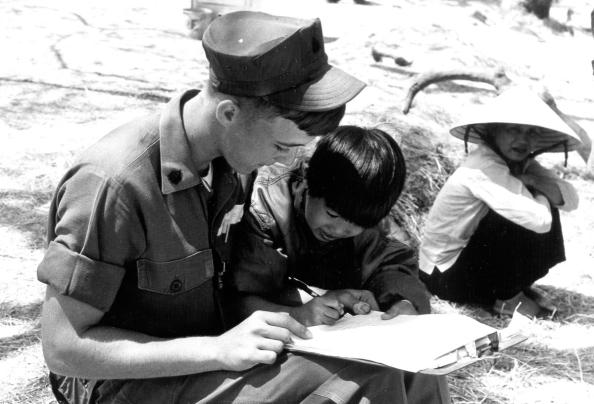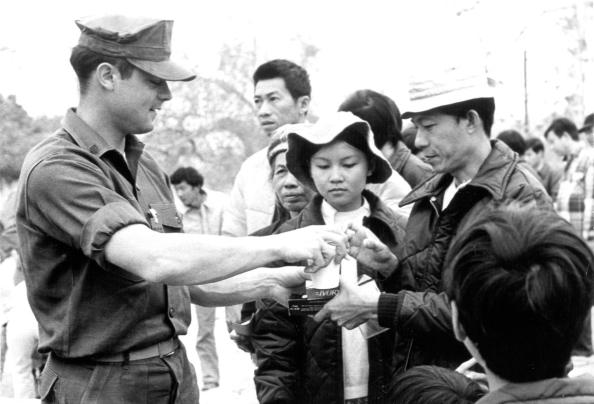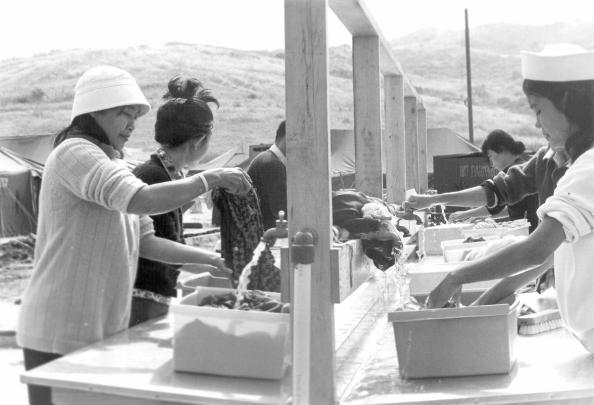Forty years ago this week, the U.S. Marines at Camp Pendleton began welcoming allies, a lot of them.
With three days to prepare, more than 1,000 Marines, sailors and civilians worked around the clock to set up a tent village for a wave of hungry and exhausted refugees from South Vietnam, the first 851 of whom arrived April 29, 1975.
The following day, Saigon, the capital of South Vietnam, fell to communist forces from the north. The war ended, and the exodus of Vietnamese refugees swelled.
“It was incredible what the Marines were able to accomplish,” said Faye Jonason, Pendleton’s chief historian. “They were dedicated to getting it done.”
Getting it done – setting up the nine tent cities and preparing for an eventual 50,000 refugees to come through – was a massive undertaking. The Marines installed sewage and communications lines. They pitched tents and refurbished Quonset huts. They came up with a plan for educating the refugees on American culture.
There were challenges for the refugees as well.
“The food was different,” Jonason said, citing one example. “At first, the Marines served scrambled eggs. (The Vietnamese) hated eggs.”
In time, the meal plan was made more culturally sensitive. But there were still the cold nights, a lack of proper clothing and language barriers – and the lingering emotional trauma of war and separation of loved ones.
But, slowly, things got better. They built a community.
“They started chatting with each other,” Jonason said, “and the kids played with each other.”
By October, the tent cities were gone, but the refugees’ American lives were just beginning.

They started chatting with each other, Faye Jonason, Pendletonís chief historian said, and the kids played with each other.
Photo taken on May 5, 1975, by Clay Miller

A Vietnamese baby girl and her grandmother play a game of “peek-a-boo” in Camp Talega, aboard Camp Pendleton, California.

Vietnamese Refugee children at Camp #6 aboard Camp Pendleton, California, gather around to watch Sunday morning cartoons on television. There is no language barrier for these children, as these children understand the American pastime of watching cartoon shows.

Vietnamese Refugee, Paul Day, formerly a Public Health Specialist in Siagon, lends his assistance to the American Medical staff handling refugees aboard Camp Pendleton by helping to fill prescriptions and pass them out to the refugee patients.

After settling in, many refugees spent their time at the volleyball courts or ping-pong tables set up by Marines.
Photo taken on May 5, 1975, by Clay Miller

Marines from 7th and 1st Engineer Battalions, First Marine Division, prepare sites for the erecting of tents, as temporary quarters for the Vietnamese refugees, at Camp Cristianitos, Camp Pendleton, CA.

Marine Sergeant J. W. Reed of H&S Company, 3rd AmTrac Battalion helps a young Vietnamese child learn to write English. The child is one of the refugees being processed through Marine Corps Base, Camp Pendleton, California.

Dr. Lance, of the Naval Regional Medical Center, Camp Pendleton, California, discuss medical subjects with a Vietnamese Refugee as she holds her child on her lap. This occurred during initial processing at Camp Cristianitos, aboard Camp Pendleton Marine Base.

Mr. Jack Harmon, the Director of the Armed Forces YMCA in Oceanside, California, plays a game with a group of young Vietnamese refugees in one of the refugee camps aboard Camp Pendleton.

Marine Sgt B. E. Branson, a member of VMO-2, Detachment, Marine Aircraft Group 16, 3rd Marine Aircraft Wing, hands out soap and toothpaste to Vietnamese Refugees in one of the refugee camps aboard Camp Pendleton, California.

Of the 50,000 Vietnamese refugees at Camp Pendleton, many were children who had to adjust to a new way of life.
Photo taken on April 30, 1975, by Clay Miller

Vietnamese refugees utilize new wash racks recently installed in Camp 6, aboard Camp Pendleton, California. The new wash racks were installed to aid the refugees in their daily washing and have replaced the single faucet type formerly used.

Finding people among 50,000 refugees was difficult. Refugees used command post walls as message boards.
Photo taken on May 5, 1975, by Clay Miller

First Vietnamese refugees arrive at El Toro Marine Air Station. Most were American dependents and workers with the U.S.. Mission.
Photo taken on April 29, 1975, by Jim Mosby

Refugees arriving from Vietnam had little more then a suitcase and the clothes on their backs.
Photo taken on April 30, 1975, by Clay Miller

In just three days, the Marines installed sewage and communications lines and pitched tents and refurbished Quonset huts for the refugees.
Photo taken on May 1, 1975, by Jim Mosby

Scene at Camp Pendleton presented a mural of confusion, yet out of it all it was people coming out of shock seeking order out of chaos. As planes were unloaded and refugees found their luggage, there was the business of being processed, the long lines to wait for official clearance, finding housing in quonset huts or tent, or settling for the moment until moving on to permanent locations. It was all a new experience for the two tightly ordered military bases. The human civilian element exploding. The very young played or slept. Some were still air sick from the long flight. A mother was helped with a newborn child. Some cried. Some laughed. The elderly sat quietly and simply waited knowing time would quit the waters of confusion and life would go on.
Photo taken April 30, 1975, by Clay Miller

Marine Sergeant G. W. Smith spends his coffee break playing with a Vietnamese child. The child is one of many Vietnamese Refugees being processed aboard Camp Pendleton, California. Sgt Smith is a member of 1st Maintenance Battalion, First Force Service Regiment, Camp Pendleton, California.

The food was different, said Faye Jonason, Camp Pendletons chief historian, citing one example. At first, the Marines served scrambled eggs. (The Vietnamese) hated eggs.
In time, the meal plan was more culturally sensitive.
Photo shot on May 5, 1975 by Clay Miller

At Camp Pendleton the refugees were safe, but there was still the cold nights, a lack of proper clothing and language barriers — and the lingering emotional trauma of war.
Photo taken on May 5, 1975, by Clay Miller

Many refugees were housed in Quonset huts. The Quonset hut got its name from the place where it was first manufactured for the Navy in the early 1940s at Quonset Point, Rhode Island. The standard size is 20 feet by 48 feet.
Photo taken on May 30, 1975, by Clay Miller

Vietnamese refugees turn the tables on Register photographer Clay Miller as they take his picture.
Photo taken on May 5m 1975, by Clay Miller

Members of the Chaffey College Children’s Touring Theater created mass excitement and joy as they sang and danced their way into the hearts of the Vietnamese Refugees at Refugees Camps 1, 2, and 3 aboard Camp Pendleton, California.

Berenice Warner, Red Cross Hospital Field Director, Navy Regional Medical Center, holds a Vietnamese infant.

Setting up the nine tent cities and preparing for an eventual 50,000 refugees to come through was a massive undertaking.
Photo taken on May 1, 1975, by Jim Mosby

A doctor’s stethoscope can be cold in any language. Navy Cmdr. Fred Leisse examines a small Viet refugee at Camp Pendleton.
Photo taken on May 5, 1975, by Clay Miller

New arrival refugees from Vietnam with volunteer teacher, Be Thi Nguyen. Nguyen taught these children English children songs and nursery rhymes.

Nearly 900 Marines and civilians worked for six days to erect the 958 tents and 140 Quonset huts that would serve as homes for Vietnamese refugees.
Camp Pendleton was the only tent city in the West; other resettlement sites were built at Fort Chaffee in Arkansas, Eglin Air Force Base in Florida and Fort Indiantown Gap in Pennsylvania.
Photo taken on April 30, 1975, by Clay Miller.
Contact the writer: 714-704-3707 or chaire@ocregister
- How they became us: Orange County changed forever in the 40 years since the fall of Saigon
- Returning to Vietnam after 40 years: Family finds their roots, but are happy to be home here
- Why Westminster? Eleven reasons the Vietnamese came to Little Saigon – and why they stayed
- Whiting: These Vietnam veterans help so others will never be abandoned again
- Blank birth certificates, cardboard boxes and freight planes: Betty Tisdale got 219 orphans out before the fall of Saigon
- PHOTOS: As a 30-year old, photographer Bill Snead chronicled life and death in Vietnam
- Guide map of Little Saigon
- Wiki: The history of Little Saigon and the Vietnamese in Orange County
- Refugees thank rescuer of Vietnamese orphans







william barr
February 13, 2016
we came home after Saigon fell and the Vietnamese got 1 % Home loans us GIs had to pay 18% and they got it all given to them.
Anonymous
January 16, 2018
That’s not true. We got refugee aid for one year. No
fezza
July 26, 2020
Good pic
https://fezzamania.wordpress.com
Anonymous
January 16, 2018
I love you America
EdinKorat Gosser
May 9, 2019
I was there in August 1975, These pics bring back memories of 4am up and on the but to Talega, 3pm on the bus back to Delmar
Larry T. Armenta
November 27, 2020
I was T.A.D. there in Nov 1975,, it sure brings back memories. I have since met 2 other Marines who where also stationed there. And only a few people I have met knew where.it was located..
Anonymous
July 28, 2020
I was a Navy “grunt” Corpsmen stationed at one of the clinics at Camp Talega during the evacuation of Vietnam. Camp Talega also had Cambodian refugees. I have photos of Camp Talega from 1975. I went to a Vietnamese wedding at Camp Talega(at the processing center). I still have the invitation. Reply if you would like—
Anonymous
March 30, 2022
Remembering Camp Telega was a L/Cpl. at the time worked security at entry post to camp first came the Vietnamese then the Cambodians also some Laotians from what I can remember.
It was one hell of an operation from the first waives that came through mostly well to do Vietnamese and then what followed. One thing I specifically remember was the food they were served some complained about cause it wasn’t their usual fare. One thing about these people it didn’t take them long to assimilate and the language and the majority have become productive Americans.
Marcus DeValentino
August 1, 2023
I was attached to HBtry 3/11 and was there at camp Talega for the onset of the heavy construction and also pulled duty with the guard company. It was hard work but, a just and rewarding experience. I am proud to be a part of this historic humanitarian mission “Operation New Arrival”. In the movie “Green Dragon”, Forrest Whitaker and the late Patrick Swayze did an awesome job in capturing the essence and success of the mission and of the pride of the Marine Corps. Semper Fi,
Marcus DeValentino Brannon, Lcpl
Anonymous
April 4, 2024
Proud of you Marine!! Semper Fi USMC Nam 68-69 Gil Jimenez fallbrook ca located at rear gate Pendleton.
Anonymous
October 28, 2023
I was there in August, 1975, as an 8 yrs. old Vietnamese refugees and these pictures bring back so much memories. My family and I were in camp 8. We love America and forever grateful.